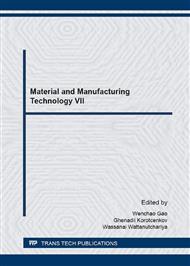p.73
p.81
p.87
p.92
p.97
p.103
p.109
p.114
p.118
Influence of Sintering Temperature on Electrical Properties of Modified-PZT Piezoelectric Ceramics
Abstract:
In this research, the effects of sintering temperature on phase structure, densification, microstructure, mechanical and electrical properties of modified-PZT ceramics were investigated. All ceramics were prepared by a conventional mixed oxide amend sintered at various temperatures from 1150 - 1250°C. XRD pattern indicated that completely solid solution occurred for all samples and the ceramics exhibited a single perovskite without any secondary phases. At lower sintering temperature, the dominant phase was rhombohedral while tetragonal phase became dominant at higher temperature. Grain size tended to increase with increasing sintering temperature. The dielectric, ferroelectric and piezoelectric properties were also increased with increasing sintering temperature. In addition, the highest low field d33 of 620 pC/N of was observed for the 1250°C sample.
Info:
Periodical:
Pages:
97-102
Citation:
Online since:
September 2016
Keywords:
Price:
Сopyright:
© 2016 Trans Tech Publications Ltd. All Rights Reserved
Share:
Citation:


